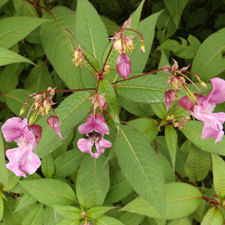 Himalayan balsam
Himalayan balsam
Common name: Himalayan balsam
Botanical name: Impatiens glandulifera
Management category: Advisory
Originally from Pakistan and India (Himalayas). It was introduced to New Zealand as an ornamental species and was recorded as naturalised in 1909.
Why is it a pest?
- Competes with native species for light, space and pollinators.
- Can dominate the vegetation on stream banks leaving them bare over winter.
- Produces a large amount of seed that is spread quickly by water.
Where is it found?
River edges, riparian areas, gullies, wetlands, forest margins, roadsides and ditches. Prefers moist soil and full sun to light shade.
What does it look like?
- Annual, hairless herb with erect, thick branched main stem that is hollow, ribbed, purple to reddish and swollen at the junction of leaves and branches.
- Sharply serrated leaves and depressed leaf veins and raised below taper to a fine point and have long, narrowly winged stalks that are pink above and scattered purplish glands.
- Pink, white or purple flowers (November to March) are held on stalks growing near the ends of upper branches and have a backwards pointing hood.
- Hairless ribbed seed capsules are usually purplish on exposed side and open when disturbed, explosively releasing shiny black seeds.
What are the rules?
Advisory
Council does not enforce the control of advisory species. It is landowner/occupier responsibility to manage these pests. Council may provide advice on how to manage or control advisory species if required.
How do you get rid of it?
- Hand-pull (all year) – seedings and small patches.
- Cut stems (spring to summer) – cut at base, no herbicide required.
- Spray (full leaf) – Glyphosate or Metsulfuron.
CAUTION: When using any herbicide or pesticide, PLEASE READ THE LABEL THOROUGHLY to ensure that all instructions and directions for the purchase, use and storage of the product, are followed and adhered to.
Read more on pest control advice, information and regulations.
Images






